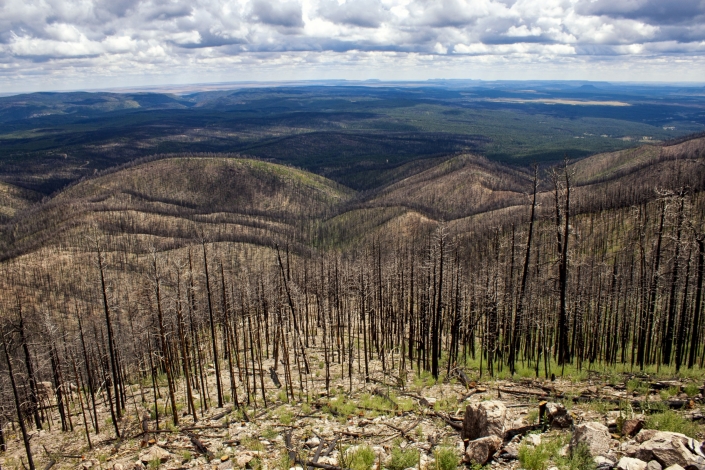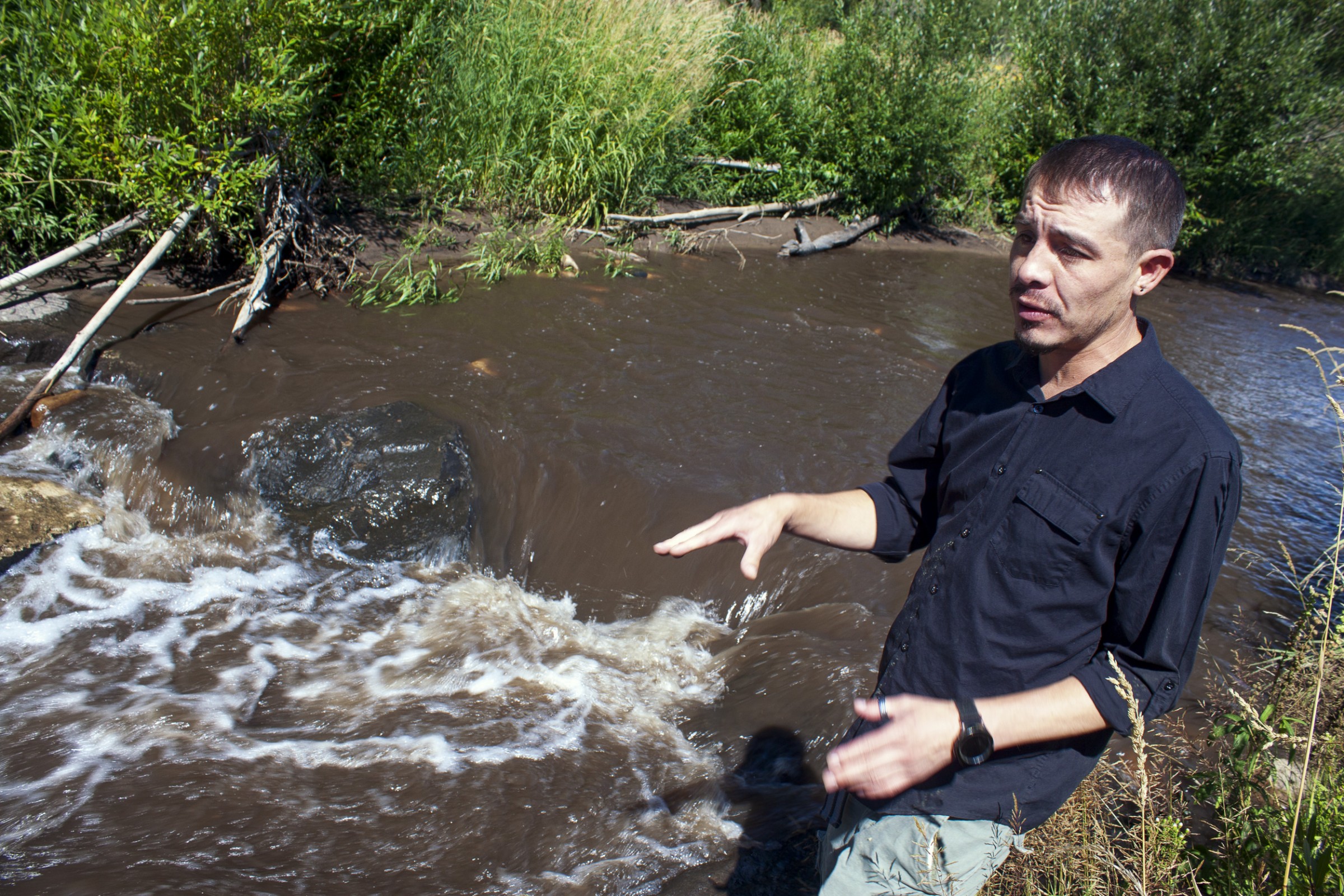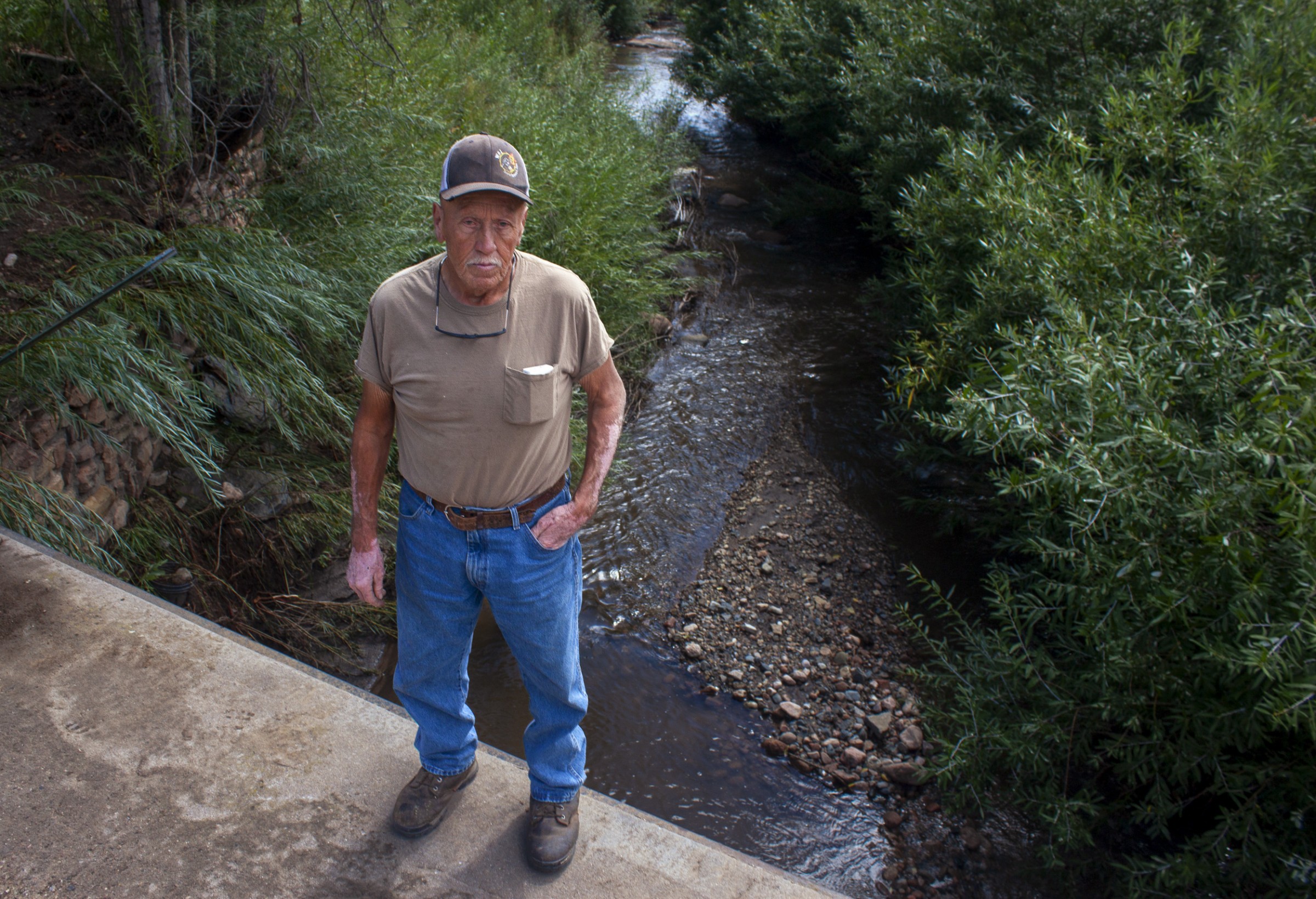 https://www.circleofblue.org/wp-content/uploads/2023/10/2023-10-New-Mexico-BWalton-6112-Edit-2500.jpg
1600
2400
Brett Walton
https://www.circleofblue.org/wp-content/uploads/2018/06/Circle-of-Blue-Water-Speaks-600x139.png
Brett Walton2023-10-25 14:39:522023-12-04 16:32:47New Mexico’s Largest Fire Wrecked This City’s Water Source
https://www.circleofblue.org/wp-content/uploads/2023/10/2023-10-New-Mexico-BWalton-6112-Edit-2500.jpg
1600
2400
Brett Walton
https://www.circleofblue.org/wp-content/uploads/2018/06/Circle-of-Blue-Water-Speaks-600x139.png
Brett Walton2023-10-25 14:39:522023-12-04 16:32:47New Mexico’s Largest Fire Wrecked This City’s Water SourceBillions in Federal Assistance after New Mexico’s Largest Wildfire. But Little Money to Repair Streams
Stream restoration beset by lack of money and workers.
By Brett Walton, Circle of Blue – November 16, 2023
LAS VEGAS, New Mexico – Patrick Gutierrez and Nick Maurer, who work for Hermit’s Peak Watershed Alliance, scramble up Canyon del Rancho, an ephemeral stream in the mountains of northern New Mexico. It’s just before noon in late August, a day after the area’s biggest rain from the summer monsoon.
Packed with soft, pliable mud, the stream bed is blanketed with evidence of the deluge. Pine needles cling to tree branches, hip high, like clothes pins. Grasses in the channel bend to the ground, pointing downstream in the direction of the flow.
Gutierrez and Maurer are inspecting the stability of water-calming structures they installed in recent weeks in this section of Canyon del Rancho, part of the Gallinas River watershed. The drainage was damaged last year in the Hermit’s Peak/Calf Canyon fire, the largest wildfire in New Mexico history. The question for the moment: Had the gusher dislodged them?
Both men are relieved by what they see. “It’s still there,” Gutierrez says, pointing at a stack of logs strung across the channel. These log mats are designed to blunt the destructive power of large volumes of water moving at high speed. In a post-fire landscape — one shorn of trees and with deep-cut stream channels — water moves in a torrent after a rainstorm. Without vegetation, streams become “peaky,” meaning a lot of water arrives at once. Those surges carry debilitating force.
Maurer, eyeing a baffle just upstream, marvels at the power of the stream flow that the weekend cloudburst unleashed. “I’m surprised that thing held, with that much water coming down,” he says.
The Hermit’s Peak/Calf Canyon fire burned 341,735 acres of public and private land in the mountains above Las Vegas. The fire and the subsequent floods chewed through the Gallinas River watershed, which is the city’s drinking water source. The fire so injured the lands and creeks that feed the Gallinas River that Las Vegas needs $140 million in new facilities to treat water that is now heavy with sediment.
Turbid water from the Gallinas and other streams in the 530-square-mile burn scar also clogged and damaged the canals of local irrigation collectives called acequias. Some farmers have gone two seasons without irrigation water, according to Paula Garcia, executive director of the New Mexico Acequia Association. “That way of life has been completely disrupted by the disasters,” she said.
The city and the field — both depend on high-quality water. Yet the on-the-ground work to rehabilitate the streams that provide that high-quality water has been neglected and under-funded in the post-fire recovery, according to interviews with people involved in the response. The forests are being reseeded and mulched, which will help hold soil in place. Dead trees are being removed.
But there’s a profound disconnect in the resources available to calm the erosive power of streams. Money and labor do not match the overwhelming need for repair.
The Hermit’s Peak/Calf Canyon fire began on April 6, 2022, due to a colossal government agency miscalculation. The U.S. Forest Service was setting small fires that day below the craggy eastern face of Hermit’s Peak. The intention was to thin an overgrown forest and reduce the risk of catastrophic fire in an area that hadn’t burned in more than a century.
That was not the outcome. Dry tinder and shifting winds propelled the prescribed fire beyond its containment lines. Three weeks later a dormant fire in nearby Calf Canyon reawakened. The combined inferno burned for more than four months until it was put out in late August.
Owing to the federal government’s responsibility in starting the fire, Congress last year passed the Hermit’s Peak/Calf Canyon Fire Assistance Act, which provides $3.95 billion to compensate property owners for fire damage and to construct a new water treatment plant to handle higher sediment levels and recycle drinking water.
With a full-time staff of four and two part-time, Hermit’s Peak Watershed Alliance, or HPWA, is one of several small organizations trying to make the watershed whole again. Lea Knutson, HPWA’s founder and executive director, sees the billions going to compensate property owners and laments that more is not available for streams. “There’s so much money out there,” Knutson said. “It’s not that easy to get. I mean, every week I hear of another source, and try to go for that source. And there’s always some obstacle for either a nonprofit getting it, or it going into river restoration.”
Damage to the forest and watershed was immediately apparent and worsened by the heavy rains of the Southwest’s summer monsoon. Downpours scoured bare hillslopes and turned rivers black. Fast-moving water flexed its might. Creeks cut through their beds like buzz saws. Knutson said the worst were incised four to five feet.
The streams carried debris that blocked some 90 acequias, according to Garcia. The acequias, at risk of repeated floods coming down the mountains, are still being dug out and rebuilt.
“It’s going to be a lifetime of work to heal these watersheds,” she reflected. She added: “Watershed restoration is so important. Our future depends on it.”
The Gallinas River, which arises from the slopes near Hermit’s Peak, is a focal point of the recovery. The river is the drinking water source for 17,000 people in and around Las Vegas. In the summer of 2022 the river was so overloaded with sediment that the treatment plant couldn’t function. At one point, the city had just 21 days of water in storage that met drinking water standards and could be delivered to residents. A concerted conservation campaign kept the city from running dry until sediment levels in the river diminished.
“The watershed is our water system,” Maria Gilvarry, director of the Las Vegas Utility Department, said. “So the more of the watershed that burns, the more that impacts our ability to treat and provide water.”

Patrick Gutierrez of Hermit’s Peak Watershed Alliance explains the organization’s work to restore streams that were damaged following the Hermit’s Peak/Calf Canyon fire. Photo © Brett Walton/Circle of Blue
Barriers to Restoration
Landowners, if they apply for a claim under the Hermit’s Peak/Calf Canyon Fire Assistance Act, can use the FEMA-administered funds to cover the cost of repairs to streams and forests on their property. Such piecemeal action, however, is less effective than a holistic watershed plan, said Reid Whittlesey, stream restoration director for Rio Grande Return, another nonprofit working in the burn scar.
FEMA also oversees an aid program to rehabilitate public infrastructure assets like roads and bridges after a disaster. But where does this leave streams? Garcia said they are the “glaring omission” in the fire recovery system. “It’s hard to do that collective work, when [streams] are not part of public infrastructure,” she said.
One problem is scale. The resources for stream recovery do not match the need. Dollars are required but pennies are being offered. Few grant programs are directed at stream restoration. A go-to funding source is the New Mexico Environment Department, but it is limited. The department’s Section 319 grant program receives about $2.3 million annually from the U.S. Environmental Protection Agency that can be used for watershed restoration activities statewide. The state-run River Stewardship Program offers an equivalent amount for water quality and habitat protection. It will see a boost starting next year with an annual allocation from the new Land of Enchantment Legacy Fund.
The federal Natural Resources Conservation operates the Emergency Watershed Protection program, but Elias Gnann, the state conservation engineer, said it is focused on protecting life and property, not necessarily stream restoration. That program has paid out $125 million in the burn scar area for seeding, mulching, sediment and debris removal, and flood protection. A second NRCS program — Watershed and Flood Operations — might consider stream restoration, Gnann said. But it is in the early planning stages of what could be a 10-year process.
Knutson offers an example of the funding mismatch. Earlier this year, HPWA reconnected a three-quarter mile segment of the Gallinas River to its floodplain, a move that will calm the river during high flows and allow it to spread out, reducing its velocity. That project cost about $500,000, she said. Using it as a baseline, Knutson did a back-of-the-envelope calculation for FEMA to estimate stream restoration costs across the entire burn scar. The total: more than $1 billion.
Other groups acknowledge that their projects can reach only so far.
“In a post-fire recovery scenario these days the fires are so enormous, that the scale that we’re able to treat is completely a drop in the bucket,” said Whittlesey of Rio Grande Return. The organization is working with a three-year, $500,000 grant from the New Mexico Environment Department.
Even if more dollars were available, the contracts might need to be reworked, said Shantini Ramakrishnan of the New Mexico Forest and Watershed Restoration Institute. Watershed recovery takes a decade or more, yet most grants extend only a couple years. The risk is that the work starts and stops. “We don’t fund long-term recovery very well,” she said.
Changing this funding structure to account for the long-tail of post-fire damage is one of the recommendations of the federal Wildland Fire Mitigation and Management Commission, a group of more than 50 national and regional fire experts tasked by Congress to recommend policy solutions to the wildfire crisis. The commission also suggested expanding existing forest programs to make watershed restoration an eligible category for funding.
Then there is the matter of labor. Everyone interviewed for this article said that New Mexico lacks stream restoration contractors. Only a handful work in the state, and they are booked.
“There are capacity issues at every level,” said Alan Klatt of the New Mexico Environment Department.
Several local programs are attempting to address the labor deficit. The New Mexico Forest and Watershed Restoration Institute is collaborating with Luna Community College on a restoration training center. Knutson of HPWA draws workers from New Mexico Highlands University and the Youth Conservation Corps and is seeking an economic development grant for worker training.
Once all those variables fall into place — funding, labor, contracts — restoration workers still need access to streams. In many cases in the burn scar, that means private lands.

Isaac Leyba stands in front of Beaver Creek, which runs along his property. “In all the years I’ve been here, I’ve never seen anything like the flooding last year,” he said. Monsoon rains in the Hermit’s Peak/Calf Canyon burn scar sent torrents of water through the creeks. Photo © Brett Walton/Circle of Blue
Recruiting Landowners
Canyon del Rancho, one of HPWA’s restoration sites, connects with Beaver Creek at the property of Isaac Leyba. Just a mile downstream, Beaver Creek meets the Gallinas River, which then flows to Las Vegas.
Leyba, a playful soul, has lived at this intersection of forest and stream for 30 years. He likes to pan for gold. “I’ve found a few specks,” he said, pulling a Native-brand cigarette from a carton in his shirt pocket and lighting it.
Restoring streams in the burn scar means HPWA has to work with hundreds of landowners like Leyba. Some 57 percent of the fire burned on private lands.
As the climate warms, especially in a drying region, enabling streams and floodplains to hold water in the high country is a net benefit to the river system as a whole, explained Whittlesey. Peaky hydrographs need to be flattened. “In the desert southwest, we need to retain as much water as possible on the landscape,” he said.
HPWA’s work with ephemeral streams is low-tech and conducted by hand. Most materials used in its projects — rocks, logs, dirt — are found on or near the site. HPWA and like-minded stream restoration outfits such as Rio Grande Return take their inspiration from beavers. Three principles prevail: slow the water down, spread it out, let it sink into the ground. Rills shouldn’t erode to become gullies. Streams should connect to floodplains. They work high in the watershed, starting from the foundational creeks that give rise to the larger rivers.
Gutierrez and Maurer know many of the people who live in the Gallinas watershed. Cultivating those relationships is a huge part of the job, they said. Without working on private lands, stream restoration in the burn scar would be patchwork and incomplete.
Leyba, for one, welcomes the ecological interventions. He watched the fire remake the watershed. Trout disappeared from the creek, he said. After every rain a fresh plug of sediment fills the channels. A three-foot diameter culvert at the end of Canyon del Rancho that was clear before the fire is now half-buried with fine-grain deposits.
“Water, you cannot stop it,” Leyba said. “It’s going to continue.”
Leyba thanked Gutierrez and Maurer for their help with the channel modifications. “These guys worked their tails off,” he said gratefully. “I hope people recognize what they did.”
The western sky took on a bruised color, darkening over the mountains above. Thunder echoed in the narrow valley. A monsoon storm was building.
Gutierrez started his vehicle and Maurer rode shotgun. They drove back toward Las Vegas, away from the clouds.
“I wonder if Lori got her hot tub yet,” Maurer mused as they passed a cluster of homes.
In the high country thunder snapped again. Within an hour the rain began.
This article was supported by The Water Desk, an independent journalism initiative based at the University of Colorado Boulder’s Center for Environmental Journalism.
Featured image: The Hermit’s Peak/Calf Canyon fire will affect the Gallinas River for years to come. Photo © Brett Walton/Circle of Blue
Read the first story in this two-part series
 https://www.circleofblue.org/wp-content/uploads/2023/10/2023-10-New-Mexico-BWalton-6112-Edit-2500.jpg
1600
2400
Brett Walton
https://www.circleofblue.org/wp-content/uploads/2018/06/Circle-of-Blue-Water-Speaks-600x139.png
Brett Walton2023-10-25 14:39:522023-12-04 16:32:47New Mexico’s Largest Fire Wrecked This City’s Water Source
https://www.circleofblue.org/wp-content/uploads/2023/10/2023-10-New-Mexico-BWalton-6112-Edit-2500.jpg
1600
2400
Brett Walton
https://www.circleofblue.org/wp-content/uploads/2018/06/Circle-of-Blue-Water-Speaks-600x139.png
Brett Walton2023-10-25 14:39:522023-12-04 16:32:47New Mexico’s Largest Fire Wrecked This City’s Water SourceBrett writes about agriculture, energy, infrastructure, and the politics and economics of water in the United States. He also writes the Federal Water Tap, Circle of Blue’s weekly digest of U.S. government water news. He is the winner of two Society of Environmental Journalists reporting awards, one of the top honors in American environmental journalism: first place for explanatory reporting for a series on septic system pollution in the United States(2016) and third place for beat reporting in a small market (2014). He received the Sierra Club’s Distinguished Service Award in 2018. Brett lives in Seattle, where he hikes the mountains and bakes pies. Contact Brett Walton
Related
© 2023 Circle of Blue – all rights reserved
Terms of Service | Privacy Policy




